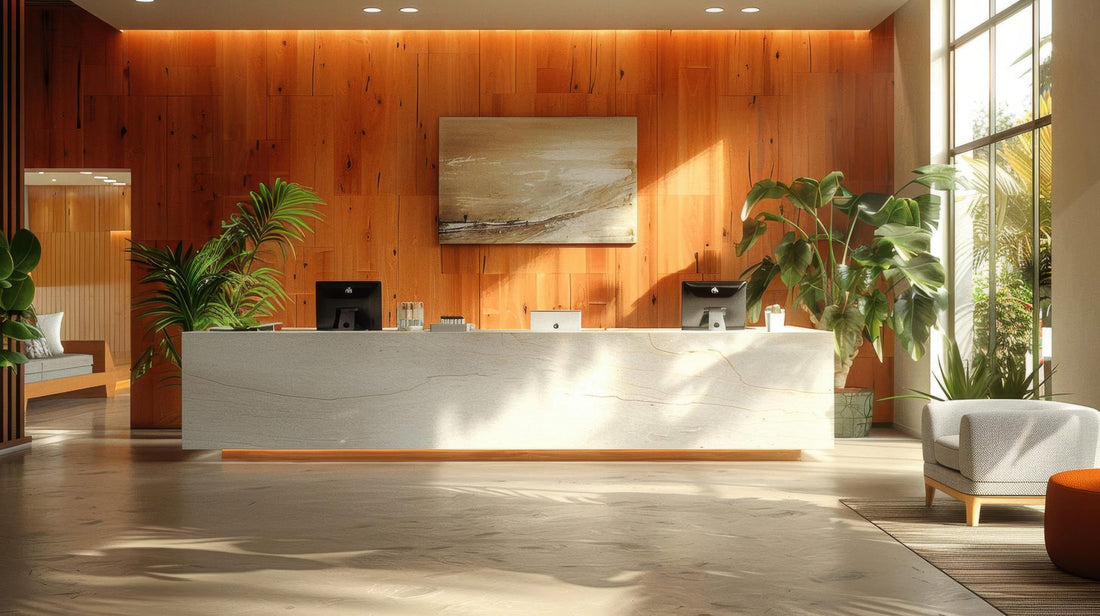
Reception Units: Essentials for Lasting First Impressions
Share
The reception area may be a waiting space, but more importantly, it's the first point of contact between your company and its clients. It sets the tone for how visitors perceive your brand from the moment they walk through the door. A well-crafted reception reflects professionalism, attention to detail, and your company’s personality. The most striking elements of this space are the reception units. They are largely overlooked, but the right reception setup can transform an ordinary lobby into a welcoming, stylish, and functional environment.
In this expert guide, we’ll explore how reception units shape first impressions, what features to look for in a quality reception counter, and how to choose one that matches your office style and brand identity. We’ll also cover complementary necessities such as lighting, seating, and décor that work alongside reception desks to create a cohesive and inviting atmosphere.
Why Reception Units Matter
Think of a reception counter as the stage on which your business’s first impression is performed. It’s where clients check in, visitors sign documents, and guests wait to be assisted. Because of this, your reception unit does more than fill a space; it also represents the heart of your office’s welcome.
- Sets the tone: A sleek, well-planned reception desk communicates proficiency, while a cluttered or outdated one can undermine your brand.
- Supports functionality: Staff need a reception area that is ergonomic, organised, and practical to deliver excellent service.
- Elevates aesthetics: As the visual centrepiece of your reception, the unit anchors the design and enhances the overall look of the space.
What to Look for in Quality Reception Units
Ergonomics
Staff at the reception desk should be comfortable while performing their duties. So, look for units built at appropriate heights, with space for seating and computer use without strain.
Storage Solutions
Built-in drawers, shelving, or cabinets help keep the reception clutter-free and make it easier to maintain a polished and professional appearance.
Branding Potential
Many modern reception desks can be customised with brand colours, logos, or distinct finishes. This ensures that your reception instantly reinforces your company identity.
Durable Materials
Materials matter since reception desks are used daily. Choose finishes like wood, glass, laminate, or metal that balance resilience with style.
Design Versatility
Explore various reception desk ideas such as curved counters for modern appeal, modular units for flexibility, or minimalist styles for a clean, contemporary look.
Reception Desk Accessories
Don’t overlook reception desk accessories like cable management systems, under-counter lighting, and privacy screens, which improve both usability and presentation.
Tips for Choosing the Right Reception Unit
Match your brand personality: A law firm may opt for a solid wood desk that conveys authority, while a creative agency might prefer a bold, modern counter with unique finishes.
- Consider space and flow: Make sure your reception desk design fits naturally into the available space while allowing easy movement for visitors and staff.
- Prioritise comfort: Receptionists regularly spend long hours at the desk, so cosiness should factor into your decision.
- Future-proof your investment: Choose a design that won’t quickly go out of style and can adapt to changing office décor.
Developing Trends in Reception Areas
Reception areas have shifted over the past decade from being purely functional spaces to dynamic brand showcases. A minimalist reception desk design, sustainable materials, and an adjustable layout have become increasingly popular, reflecting the broader emphasis on eco-consciousness and flexibility in office environments. Technology has also made a feature, with digital check-in systems and integrated lighting adding convenience and sophistication. Today, reception units are curated for efficiency but also to create an experience that mirrors a company’s culture and values.
The Future of Reception Design
Looking ahead, reception areas are set to become even more interactive and digitised. AI-powered visitor management systems, touchless check-ins, and smart lighting will simplify the welcome process while reinforcing safety and productivity. Hybrid workspace trends are also influencing reception desk design, with modular counters that can adapt to flexible office arrangements. As businesses continue to emphasise user experience and sustainability, reception units of the future will balance high-tech functionality with eco-friendly materials and timeless aesthetics.
Beyond the Desk: Creating a Cohesive Reception Area
The best reception furniture may be the focal point, but it should work in harmony with other elements in the space:
- Lighting: Soft, layered lighting makes the area feel warm and inviting while highlighting the desk.
- Seating: Comfortable chairs or sofas show you care about visitor experience. Choose designs that complement the reception counter.
- Décor & Greenery: Art, branded signage, or plants can add personality and warmth.
- Technology: Consider incorporating digital check-in systems or display screens to modernise the visitor experience.
The Lasting Impact of a Thoughtful Reception
A beautiful reception area is your company’s handshake before words are spoken. Over the past decade, trends have moved towards minimalism, sustainability, and tech integration, and the future promises even more innovation, from AI-driven visitor systems to modular, hybrid-ready configurations. Through all these changes, one element remains constant: the worth of a well-chosen reception unit. Your reception will reflect your brand today and adjust to tomorrow’s workplace needs when you invest in a desk that blends style, durability, and functionality.
Explore Ixaxa Office’s space planning solutions to find the perfect fit for your space, style, and brand identity.
